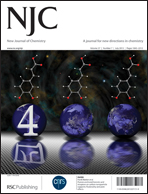Two ternary yttrium(III) oxomolybdates(VI) are investigated, both structurally and spectroscopically. The crystal structure of Y2[MoO4]3 was solved at room temperature in the orthorhombic space group Pba2 (a = 1030.21(3), b = 1032.41(3), c = 1057.25(3) pm, Z = 4). In the unit cell, three discrete ortho-oxomolybdate(VI) units [MoO4]2− and two Y3+ cations, both with CN = 7 featuring a monocapped trigonal-prismatic oxygen environment, can be distinguished. Y2[MoO4]2[Mo2O7] crystallizes monoclinically in the space group P21/c (a = 681.85(2), b = 959.13(3), c = 1052.99(3) pm, β = 105.586(2)°) with two formula units per unit cell. In this compound the anionic environment of the crystallographically unique Y3+ cations also comprises seven oxygen atoms forming a monocapped trigonal prism. Furthermore, the crystal structure features both tetrahedral [MoO4]2− and pyroanionic [Mo2O7]4− entities, the latter in staggered conformation, with the bridging oxygen atom between the two vertex-shared [MoO4]2− tetrahedra residing on an inversion centre. Besides self-activated emission, resulting from the oxomolybdate(VI) units (maximum at around 600 nm), both compounds have the potential to be used as luminescence host materials, shown by spectroscopic studies involving Eu3+ as a sensitive probe. The emission spectra of Y2[MoO4]3:Eu3+ and Y2[MoO4]2[Mo2O7]:Eu3+ are dominated by the Eu3+-typical 5D0 → 7F2 transition at 614 nm. In the excitation spectra, aside from 4f-interconfigurational Eu3+ transitions at lower energies, broad charge-transfer (CT) bands due to O2− → Eu3+ or O2− → Mo6+ transitions dominate at higher energies. Comparing the diffuse reflectance spectra (DRS) of the undoped with the Eu3+-doped materials, the O2− → Mo6+ LMCT process proves to be crucial for the position of the broad CT band in the excitation spectra of both yttrium oxomolybdates(VI).
![Graphical abstract: Yttrium(iii) oxomolybdates(vi) as potential host materials for luminescence applications: an investigation of Eu3+-doped Y2[MoO4]3 and Y2[MoO4]2[Mo2O7]](/en/Image/Get?imageInfo.ImageType=GA&imageInfo.ImageIdentifier.ManuscriptID=C3NJ00166K&imageInfo.ImageIdentifier.Year=2013)

 Please wait while we load your content...
Please wait while we load your content...